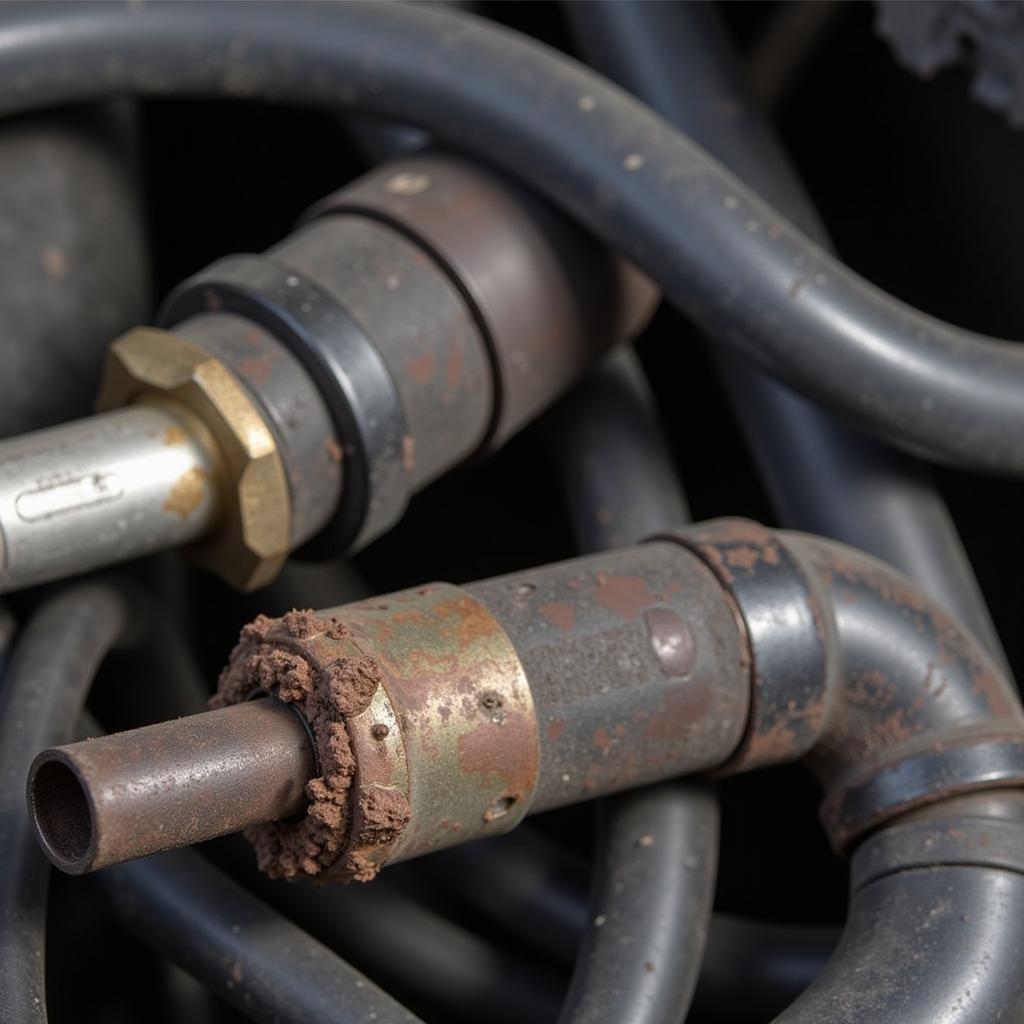The dreaded PO2098 code. It’s a common issue for Mercedes owners with the 2.6L engine, signifying a “Post Catalyst Fuel Trim System Too Rich Bank 1.” This article provides a deep dive into the PO2098 code, its causes, diagnostic procedures, and effective solutions, empowering you to tackle this problem head-on.
Understanding the Mercedes 2.6 PO2098 Code
The PO2098 code indicates that the oxygen sensors downstream of the catalytic converter are detecting a richer-than-expected exhaust mixture. This means there’s an excess of fuel compared to air after the catalytic converter has attempted to clean up the exhaust gases. While this might seem straightforward, diagnosing the root cause requires a systematic approach. Ignoring this code can lead to reduced fuel economy, increased emissions, and potentially damage to the catalytic converter.
Common Causes of the PO2098 Code in Mercedes 2.6L Engines
Several factors can contribute to the PO2098 code. Understanding these potential culprits is crucial for effective diagnosis and repair. Some of the most frequent causes include:
- Faulty Oxygen Sensor: A malfunctioning downstream oxygen sensor can provide inaccurate readings, triggering the PO2098 code.
- Exhaust Leaks: Leaks in the exhaust system, especially after the catalytic converter, can introduce fresh air, skewing the oxygen sensor readings and causing a false rich condition.
- Fuel Injector Problems: Leaky or stuck-open fuel injectors can deliver excessive fuel, resulting in a rich mixture and the PO2098 code.
- Fuel Pressure Regulator Malfunction: A faulty fuel pressure regulator can cause abnormally high fuel pressure, leading to over-fueling and the PO2098 code.
- Mass Airflow Sensor (MAF) Issues: An inaccurate MAF sensor reading can cause the engine control module (ECM) to miscalculate the required fuel amount, potentially leading to a rich mixture.
- EVAP System Leaks: Leaks in the evaporative emissions control (EVAP) system can allow fuel vapors to enter the intake manifold, disrupting the air-fuel mixture and triggering the PO2098 code.
- Catalytic Converter Issues: Although less common, a failing catalytic converter can also contribute to the PO2098 code.
 Faulty Oxygen Sensor in Mercedes 2.6
Faulty Oxygen Sensor in Mercedes 2.6
Diagnosing and Fixing the Mercedes 2.6 PO2098 Code
Accurately diagnosing the cause of the PO2098 code is crucial for a successful repair. Here’s a step-by-step guide:
- Retrieve Diagnostic Trouble Codes (DTCs): Use an OBD-II scanner to retrieve any stored DTCs, including the PO2098 code and any other related codes.
- Inspect for Exhaust Leaks: Thoroughly inspect the exhaust system for any leaks, especially downstream of the catalytic converter.
- Check Fuel Pressure: Test the fuel pressure to ensure it’s within the manufacturer’s specifications.
- Test Oxygen Sensors: Test the downstream oxygen sensors using a multimeter or a dedicated oxygen sensor tester.
- Inspect Fuel Injectors: Check for leaking or stuck-open fuel injectors.
- Test MAF Sensor: Test the MAF sensor using a multimeter or a scan tool.
- Inspect EVAP System: Check for leaks in the EVAP system.
Once the root cause is identified, you can implement the appropriate repair. This might involve replacing a faulty oxygen sensor, repairing an exhaust leak, replacing a fuel injector, or addressing other underlying issues.
“Accurate diagnosis is key when dealing with the PO2098 code. Don’t just throw parts at the problem. A systematic approach will save you time and money in the long run.” – John Smith, Automotive Diagnostics Specialist
Preventing Future PO2098 Codes
Regular maintenance plays a crucial role in preventing the PO2098 code and other related issues. This includes:
- Regular Oil Changes: Use the correct oil type and change it according to the manufacturer’s recommendations.
- Fuel System Cleaning: Periodically clean the fuel system using a quality fuel system cleaner.
- Air Filter Replacement: Replace the air filter as recommended by the manufacturer.
- Spark Plug Replacement: Replace spark plugs according to the manufacturer’s maintenance schedule.
Conclusion
The Mercedes 2.6 PO2098 fix requires a thorough understanding of the code, its potential causes, and the appropriate diagnostic procedures. By following the steps outlined in this article, you can effectively diagnose and resolve the PO2098 code, ensuring optimal performance and longevity for your Mercedes.
FAQ
- What does the PO2098 code mean? It indicates a rich fuel mixture after the catalytic converter.
- Can I drive with the PO2098 code? While you might be able to drive, it’s recommended to address the issue promptly to prevent further damage.
- Is the PO2098 code expensive to fix? The cost depends on the underlying cause. A simple oxygen sensor replacement can be relatively inexpensive, while more complex repairs can be costly.
- How can I prevent the PO2098 code? Regular maintenance is key to preventing this and other related issues.
- What tools do I need to diagnose the PO2098 code? An OBD-II scanner, multimeter, and potentially other specialized tools might be required.
- Can an exhaust leak cause the PO2098 code? Yes, leaks after the catalytic converter can introduce fresh air and trigger the code.
- Can a faulty MAF sensor cause the PO2098 code? Yes, an incorrect MAF reading can lead to over-fueling and the PO2098 code.
Need further assistance? Contact us via Whatsapp: +1 (641) 206-8880, Email: CARDIAGTECH[email protected] or visit us at 276 Reock St, City of Orange, NJ 07050, United States. Our 24/7 customer service team is ready to help.

